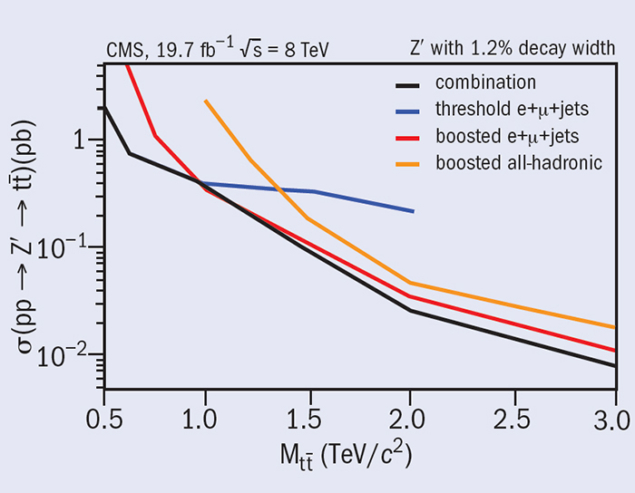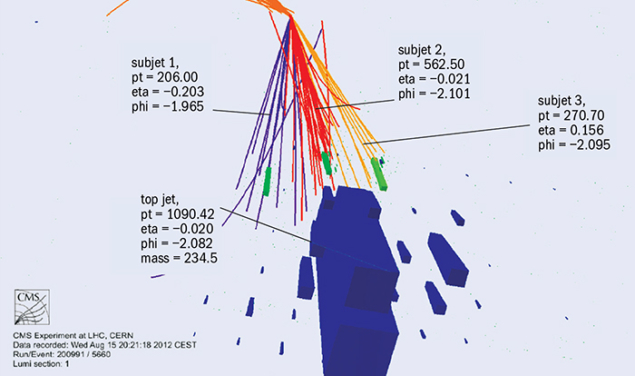
While analyses are progressing to ascertain the consistency of the new boson discovered at the LHC with the Standard Model Higgs boson (H), the LHC collaborations continue to develop tools in their search for new physics that could lead beyond the Standard Model, and cast light on the many fundamental open questions that remain.

The LHC can now reach energies far above those needed to produce Standard Model particles such as W/Z/H bosons and top quarks. The extra energy results in massive final-state particles with high Lorentz boosts (γ > 2), i.e. “boosted topologies”. Searches for new physics at the LHC often involve these boosted topologies, so it is necessary to extend the particle-physicists’ toolkit to handle these cases. This includes investigation of non-isolated leptons, overlapping jets that contain “substructure” from the decay of the Standard Model particles, and bottom-quark jets that merge with nearby jets. Classical techniques fail to capture these challenging topologies, so new techniques must be developed to ensure the broadest sensitivity to new physics.

To analyse these topologies, much theoretical and experimental understanding has been accomplished during the past few years. Now the CMS collaboration has published searches involving boosted W/Z/H bosons and top quarks, using a large suite of tools to improve sensitivity by factors of around 10 over classical techniques. This suite of tools includes identifying leptons within boosted top-quark decays, identifying W and top-mass peaks inside merged jets, and identifying bottom-quark jets embedded within merged jets.
Figure 1 shows an event display of a boosted top-quark candidate recorded by CMS in 2012. The energy deposits in the calorimeters are shown as blue and green boxes, while the tracks are indicated with coloured lines. This jet has been found to exhibit a three-prong substructure that has been resolved with dedicated algorithms.
In the first analyses using these techniques, large improvements have been observed in high-mass sensitivity. Figure 2 shows the observed limits for a tt resonance search with and without using these boosted techniques. The blue line highlights the sensitivity of such a search using traditional, non-boosted techniques. The red and orange lines highlight the sensitivity using boosted techniques. At a mass, m, of 2 TeV, the sensitivity of the boosted techniques is 10 times better than traditional techniques.
This is just one of many analyses in which these new techniques have been deployed (see further reading below), and with a firm grasp on the relevant physics gained from experience in the LHC’s Run 1, CMS is now poised to apply the techniques broadly in Run 2.
Further reading
Searches for tt̅ resonances: 2013 Phys. Rev. Lett. 111 211804.
Searches for tb resonances: http://cds.cern.ch/record/1751504?ln=en.
Searches for vector-like quarks: 2014 Phys. Rev. Lett. 112 171801 and Phys. Lett. B 729 149; http://cds.cern.ch/record/1599436?ln=en; http://cds.cern.ch/record/1752557?ln=en; https://cds.cern.ch/record/1706121?ln=en.
Searches for stop quarks: http://cds.cern.ch/record/1635353.
Searches for VV resonances: 2014 JHEP08(2014)173 and JHEP08(2014)174.







